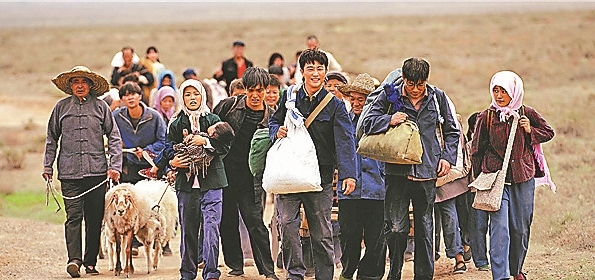
A TV drama series about the country’s poverty alleviation efforts has become popular overseas, garnering millions of views on YouTube. “Shanhaiqing,” also known by its English title “Minning Town”, follows villagers in the 1990s in Xihaigu, Northwest China’s Ningxia Hui Autonomous Region, as they are relocated from the deep mountains to a habitable region near the Yellow River. They build their new homes in Minning from scratch with assistance from East China’s Fujian Province, a relatively wealthy coastal province. “Shanhaiqing” roughly translates to “Mountain and Sea Love,” which implies the joining of hands by Ningxia and Fujian. The real-life history behind the drama is even more touching. A total of 66,000 relocated villagers, groups of front-line officials and experts from Fujian are the stars fighting poverty in Xihaigu, a region that has suffered from barren land, drought and a fragile ecological environment. It was labeled a “most unfit place for human settlement” by the United Nations in 1972. Xie Xingchang, the inspiration for lead character Ma Defu in the drama and former Party secretary in Funing village, Minning Town, says the TV drama mirrors a large part of what happened in real life, but the reality was much more bitter. In 1996, the Central Committee of the Communist Party of China made a strategic decision to promote a pairing-up support scheme between East and West China. Affluent areas were tasked with helping less developed regions, and the coastal province of Fujian was paired with Ningxia. Relocating villagers living in arid mountain areas to habitable regions near the Yellow River was a key project back then. July 15, 1997 is a day carved in Xie’s memory. That was when construction began for Minning village, jointly built by Fujian and Ningxia near Ningxia’s regional capital of Yinchuan. As the area was still an undeveloped wasteland, only 13 households agreed to “emigrate” with Xie, even after two mobilization campaigns. “Traveling more than 400 kilometers from my hometown to Minning village took us 12 hours on three-wheeled motorcycles. We had to sleep on the floor on the night we arrived. The next day, we moved bricks and bought wood to build a house,” said Xie, 66. He remembers a day when his wife was cooking inside a tent and a sandstorm suddenly hit. “The tent was blown away, leaving my wife with a pot in her arms and a quilt under her feet,” he said. (China Daily) | 
